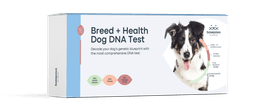Sunny weather and a beautiful day, you are enjoying it with your furry friend when they suddenly start dragging their rear end across the floor like they’re practicing for some skidding contest. At first, you might think it is weird or just laugh it off, but it keeps happening repeatedly, and you wonder, “Is this normal?” The problem: your dog's anal glands.
You're not alone if you've never heard about dog anal glands. A lot of dog owners are unaware of this common issue. This article will show you how to get your dog feeling better without the scooting and discomfort.
What Are Anal Glands?
The anal glands in dogs are tiny glands located on either side of their anus. These are sacs that are relatively comparable to the size of a pea or a grape (depending on the size of the dog) which are positioned about at four and eight o'clock.
These glands or sacs release a small amount of smelly fluid mostly when your dog poops (and sometimes when they are frightened or anxious). It’s their signature scent, like a doggie business card, letting other dogs know who’s been around. This way, they can mark their boundaries and serve as a way of communication.
Why Anal Gland Expression Is Necessary
Before going into the details of dogs' anal gland expression, let us first identify how they normally function. A healthy dog with a healthy diet forms firm stools and expresses these glands naturally with the help of the compression effect from the stool coming out.
But now and then, this normal expression doesn’t occur because the dog has soft stool due to a low-fiber diet or some kind of blockage due to constipation.
This may lead to the gland being full, impacted, or infected, leading to discomfort and a change in behavior in your dog. These may need help in manually expressing anal glands, meaning squeezing the content out by using the fingers. However, this procedure should only be done after consulting with your vet.
How to Identify If Your Pet Needs Anal Gland Expression
Visual and Behavioral Signs
According to an article by PetMD, there are several signs your dog will use to let you know about the discomfort. These can include scooting the rear end along the floor. Like a baby crying when something is wrong, the dog says, “Hey, I’m uncomfortable here!” It may look funny, but it’s a sign your dog’s trying to relieve the pressure.
Other symptoms of blocked anal glands in dogs include excessive licking of the anal area, straining or difficulty when pooping. Sometimes, there might also be blood or pus in the stool or near the rectum. Moreover, if the sacs are full, there will be a strong, stinky, pungent, or fishy odor from the dog that may prompt you to look for the cause.
When to Act
Take action immediately if you observe any of these symptoms. To be sure nothing serious is going on, scheduling a veterinary visit might be a smart option if this is your first experience with the problem. You can express the glands at home, though, if your dog has experienced this problem in the past and you feel comfortable doing so, after consulting your veterinarian remotely.
The Process of Anal Gland Expression
Expressing anal glands requires manually compressing the anal sac from outside and inside the anal canal. Thus, to make it safe, always consult with a veterinarian.
Step-by-Step Guide
Here we are going to follow the steps outlined by The American Kennel Club (AKC) in performing the procedure.
Step 1: Get your materials ready. Since expressing anal glands can get messy and smelly, consider wearing disposable gloves and a mask. Have wipes, paper towels, and petroleum jelly handy, and a washcloth with warm water ready for cleanup.
Step 2: Make your dog comfortable. Consider providing them with a toy or treat to distract them or ask someone to help you.
Step 3: Begin the anal gland expression. You apply the petroleum jelly to your thumb and index finger of one hand before placing them on each side of your dog's anus, where the anal glands are located. After inserting your finger, put pressure on the anus around the 4 and 8 o'clock positions if you think of it as a clock face.
Step 4: Release the fluid. To keep it clean, place a paper towel in front of the anus and beneath the anal glands with your other hand. Squeeze the anal glands together gently with your thumb and index finger to release the fluid from both sides. Note that the liquid should be brown. If the fluid appears thicker than a liquid or a different color, call a vet immediately.
Step 5: Clean your dog up. Hurray, you are done! Now you wipe the region surrounding your dog's anus, including the fur around it, using a washcloth and warm water.
Precautions
As you express the canine’s anal glands, take care to avoid hurting or upsetting them. Excessive pressure might cause harm or injury to the anal glands. Experts recommend always using little pressure; if the fluid doesn't come out readily or you sense resistance, stop and speak with your veterinarian. Inflammation or even gland rupture brought on by improper expression might result in more serious issues. It is usually safer to get expert guidance from a veterinarian if you are unsure about the procedure.
Hygiene is another important safety measure. Always wear disposable gloves during the potentially messy and bacterial process, and carefully clean the area afterward to avoid contamination or illnesses. Additionally, be sure to thoroughly clean your dog's fur and the surrounding area after the expression.
When to Seek a Professional
It is always important to be keen in seeking professional help. It's time to call the vet if your dog appears to be in severe discomfort or if you notice that area is red and touching it causes any discomfort to your pet. or if the fluid is thick and contains blood.
Furthermore, if you see that your dog needs their glands expressed regularly, this may indicate a persistent problem that needs to be treated by a veterinarian.
Managing and Preventing Anal Gland Issues
It's not required to express anal glands in dogs regularly to avoid build-up, despite the appealing thought that you should. Regularly expressing your dog's glands may seem like a smart idea to avoid problems, but it's not always required. A vet can help you understand when, why, and how often it should be done.
Diet and Its Role in Anal Gland Health
A high-fiber diet can do wonders for your dog’s anal glands. Fiber helps produce firmer stools, which naturally express the glands. You can add more fiber to your dog’s diet by introducing pumpkin, sweet potatoes, or green beans. Always consult your vet before making any major dietary changes.
Regular Check-Ups and Grooming
Regular grooming and veterinary exams can also aid in identifying anal gland problems before they worsen. It's important to monitor dogs closely since some breeds, particularly smaller ones such as poodles, chihuahuas, and beagles, are more susceptible to anal gland issues.
Potential Complications of Anal Gland Issues
Infections and Abscesses
Abscesses may form in anal glands that are affected or diseased. Painful, swelling, pus-filled regions known as abscesses can burst if left untreated. Anal puffiness, redness, excessive licking, or pain are indicators of an infection. Should the infection worsen, the dog can also exhibit feverish symptoms or lethargic behavior. You may occasionally observe pus or blood in the feces. If an abscess is serious, drainage or even surgery may be necessary.
Chronic Problems
Chronic inflammation or scarring of the anal glands can increase the risk of complications, such as fistulas (abnormal openings) or ruptures, which require specialized care. Dogs with chronic problems may require frequent gland expressions, special dietary modifications, or in more severe cases, surgery to remove the anal glands. This procedure is known as an anal sacculectomy and may be necessary if infections are recurring or if the glands are still a problem that does not respond to other treatments.
Conclusion
In conclusion, anal gland expression is an important topic to know when taking care of your dog. Even though it feels unusual, it contributes a lot to your dog’s wellbeing. Thus recognizing what signs to look for and how to address them as well as knowing the potential complications and when to talk to your vet is quite important to keep at heart.
Frequently Asked Questions
How to tell if a dog's anal glands are full?
If you see your dog scooting, licking their rear end, visible discomfort when pooping as well as the fishy and pungent smell coming out of the rear end that are the tell-tale signs of full anal glands.
How often should the anal glands of my dog be expressed?
Your dog will not require expression if they have never had gland problems. Nevertheless, expression can be necessary if you see symptoms like scooting or pain. For tailored guidance, speak with your veterinarian.
What are the signs of infected anal glands?
Swelling, redness, and intense pain in the vicinity of the anal region are symptoms, as well as blood or pus in the stool. Visit a veterinarian right away if you notice these.
Does my dog need a special diet for anal gland health?
By encouraging firmer stools, a high-fiber diet can help avoid gland problems. Additions such as sweet potatoes, pumpkin, and green beans can be beneficial.
Can frequent anal gland expression harm my dog?
It might irritate when the glands are overexpressed. Don't express them unless your veterinarian recommends it.



